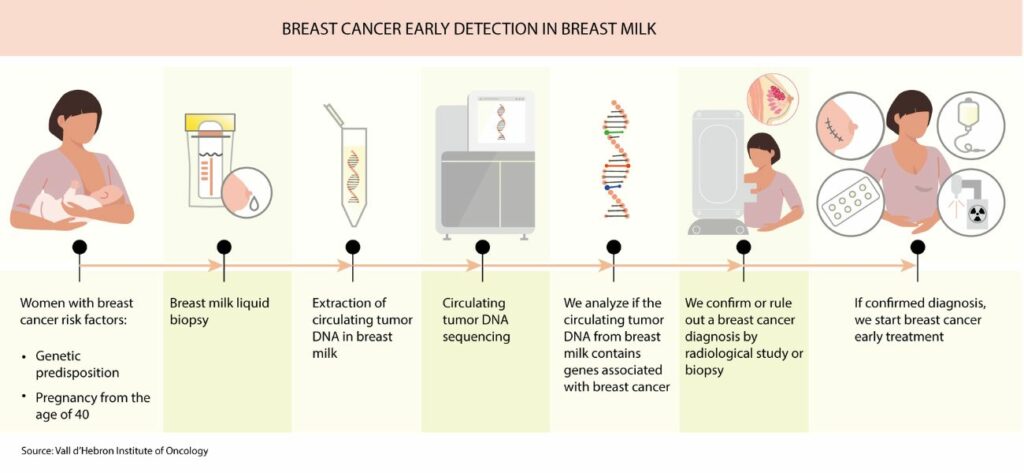Researchers at VHIO, led by Dr. Cristina Saura and Dr. Ana Vivancos, have made a groundbreaking discovery. They found that breast milk from breast cancer patients contains circulating tumor DNA (ctDNA), a type of tumor DNA. This ctDNA can be detected in breast milk through a liquid biopsy and may serve as a new tool for early breast cancer diagnosis in the postpartum period.
The research aimed to address the challenge of diagnosing breast cancer during and after pregnancy, which often leads to later-stage diagnoses. The study is an essential step in improving early detection, especially since physiological changes during pregnancy and postpartum make tumors more challenging to find, and these cancers tend to be more aggressive. The research findings have been published in the journal Cancer Discovery.
A breast cancer patient’s worries sparked a unique research project. Unlike other scientific fields, biomedical research often involves patients’ experiences and questions. In this instance, a breast cancer patient who was diagnosed while pregnant with her third child was concerned that she might have passed the tumor through her breast milk to her second child during breastfeeding, which continued until shortly before her breast cancer diagnosis.
“The patient,” explains Dr. Saura, “brought us a sample of breast milk that she had stored in her freezer. So, thanks to her, that’s where our project started because although we know that breast cancer is not transmitted through breast milk, we decided to analyze the sample in search of markers that could help us in our research. Indeed, when we analyzed the patient’s breast milk, we found DNA with the same mutation that was present in her tumor. The breast milk had been frozen more than a year before the patient’s cancer diagnosis”.
Liquid blood biopsy is currently used to detect specific mutations in metastatic breast cancer patients. However, it’s less effective for early diagnosis or predicting relapse due to its need for a high amount of circulating tumor DNA in the blood. In recent years, liquid biopsy methods have been extended to screen for other cancers in urine and saliva. Researchers wondered if breast milk, being close to the tumor, could be a suitable source for liquid biopsy.
The study, now published in the journal Cancer Discovery, presents the initial findings where breast milk and blood samples were collected from breast cancer patients diagnosed during pregnancy or postpartum, as well as from healthy breastfeeding women.
The research team used two techniques, Next Generation Sequencing (NGS) and Droplet Digital PCR (ddPCR), to analyze breast milk and blood samples. They discovered that breast milk from breast cancer patients contained tumor-originating free circulating DNA, with 13 out of 15 patients showing mutations present in their breast tumors in their breast milk samples. In comparison, ctDNA was only detected in one of the blood samples collected simultaneously.
The two patients in whom the mutation wasn’t found had colostrum samples. This indicates that more time is needed for tumor DNA to appear in breast milk. This discovery suggests that liquid biopsy can detect breast cancer even before conventional imaging methods. To make this discovery practical, they created a genomic panel called VHIO-YWBC, which can identify the most common mutations in young breast cancer patients with over 70% sensitivity and 100% specificity.
The newly designed gene panel, VHIO-YWBC, may become a method for early breast cancer diagnosis, particularly in the postpartum period. Similar to how newborns receive a heel prick for screening, collecting breast milk samples from new mothers could be considered a breast cancer screening method.
The study showed promising results when they tested the breast milk of high-risk women in the follow-up at eight and eleven months postpartum. It revealed that the gene panel could potentially diagnose breast cancer earlier than traditional methods, as mutations were detected in breast milk samples even before visible signs in breast ultrasound scans.
To confirm its usefulness, a study will collect breast milk samples from 5,000 healthy women worldwide who became pregnant at 40 years of age or older or have specific breast cancer risk-increasing mutations. This non-invasive technique opens possibilities for early breast cancer detection in young mothers and women, ultimately aiding in improved survival and cure rates.

Dr. Saura explains, “This research was possible thanks to the involvement of breast cancer patients and the various sponsorship initiatives that have supported the project, such as the El Paseíco de la Mama, which allowed us to start this study from scratch. Thanks to them, we have been able to generate the preliminary data for the study and then submit the project to competitive calls for grants. We currently have more than €300,000 raised through competitive grants from the FERO Foundation, “la Caixa” Foundation, SEOM, AECC (with the support of Loterías y Apuestas del Estado), ISDIN, and FIS (of the Carlos III Health Institute) to continue this research.”
VHIO’s research reveals the potential of breast milk liquid biopsy for early breast cancer diagnosis, with the development of the VHIO-YWBC gene panel showing promising results. This non-invasive approach could significantly contribute to the early detection of breast cancer, particularly in young women and mothers, ultimately enhancing survival rates.
Journal reference:
- Cristina Saura, Carolina Ortiz, et al., Early-Stage Breast Cancer Detection in Breast Milk. Cancer Discovery. DOI: 10.1158/2159-8290.CD-22-1340.
